HI6005 Management Report: Goal Setting and Planning in Organizations
VerifiedAdded on 2023/06/12
|15
|4302
|494
Report
AI Summary
This report discusses the significance of goal setting in planning, highlighting the characteristics of well-defined goals for managers. It explores Miles and Vergen's study on goal setting, emphasizing the three conditions necessary for best practices. The report also delves into management by objectives (MBO) and the contingency factors that influence a manager's approach to planning, including government regulations, profitability, and other considerations. Furthermore, it examines different types of plans, such as strategic, operational, tactical, and contingency plans, underscoring their importance to an organization's success. The paper concludes by reinforcing the vital role of effective goal setting and planning in achieving organizational objectives.
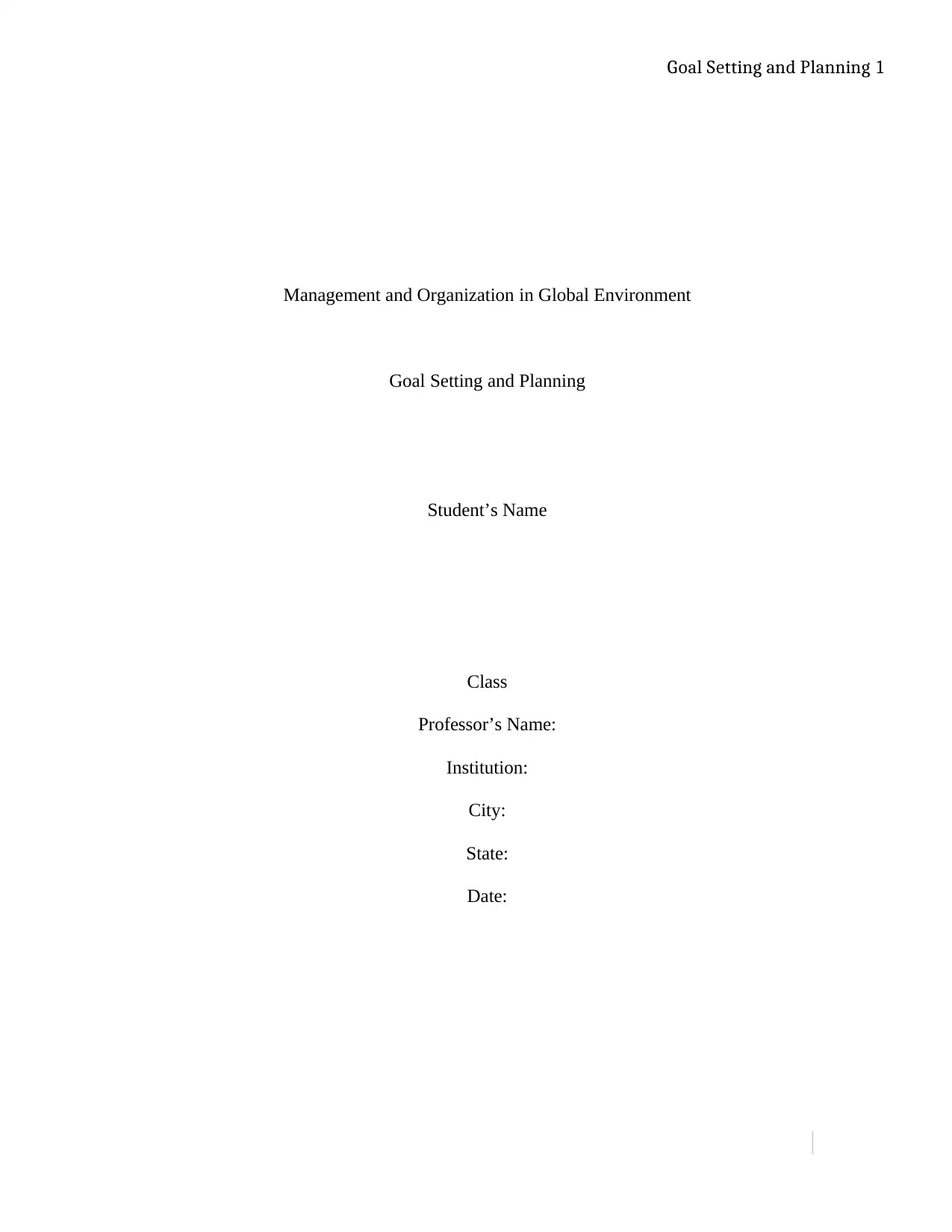
Goal Setting and Planning 1
Management and Organization in Global Environment
Goal Setting and Planning
Student’s Name
Class
Professor’s Name:
Institution:
City:
State:
Date:
Management and Organization in Global Environment
Goal Setting and Planning
Student’s Name
Class
Professor’s Name:
Institution:
City:
State:
Date:
Secure Best Marks with AI Grader
Need help grading? Try our AI Grader for instant feedback on your assignments.
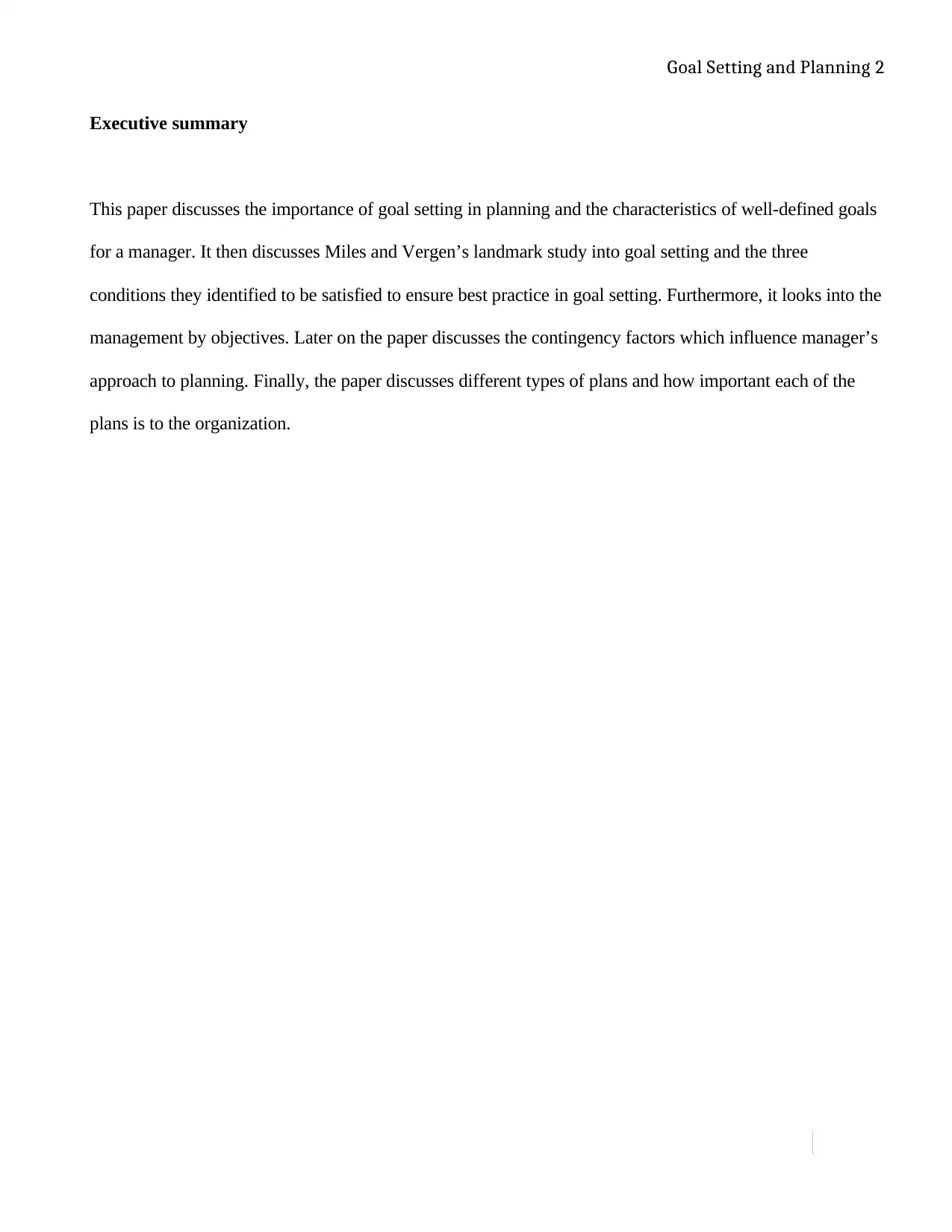
Goal Setting and Planning 2
Executive summary
This paper discusses the importance of goal setting in planning and the characteristics of well-defined goals
for a manager. It then discusses Miles and Vergen’s landmark study into goal setting and the three
conditions they identified to be satisfied to ensure best practice in goal setting. Furthermore, it looks into the
management by objectives. Later on the paper discusses the contingency factors which influence manager’s
approach to planning. Finally, the paper discusses different types of plans and how important each of the
plans is to the organization.
Executive summary
This paper discusses the importance of goal setting in planning and the characteristics of well-defined goals
for a manager. It then discusses Miles and Vergen’s landmark study into goal setting and the three
conditions they identified to be satisfied to ensure best practice in goal setting. Furthermore, it looks into the
management by objectives. Later on the paper discusses the contingency factors which influence manager’s
approach to planning. Finally, the paper discusses different types of plans and how important each of the
plans is to the organization.
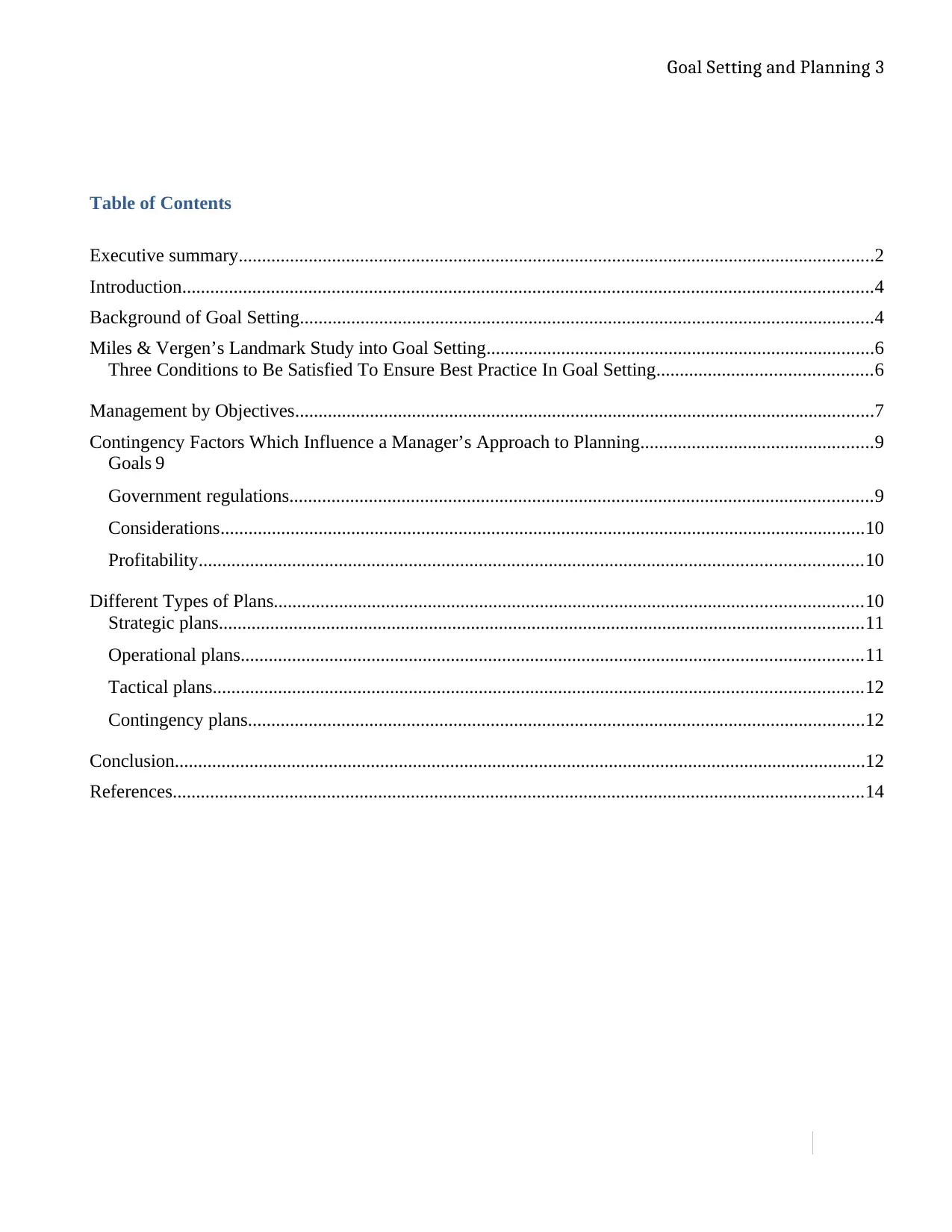
Goal Setting and Planning 3
Table of Contents
Executive summary........................................................................................................................................2
Introduction....................................................................................................................................................4
Background of Goal Setting...........................................................................................................................4
Miles & Vergen’s Landmark Study into Goal Setting...................................................................................6
Three Conditions to Be Satisfied To Ensure Best Practice In Goal Setting..............................................6
Management by Objectives............................................................................................................................7
Contingency Factors Which Influence a Manager’s Approach to Planning..................................................9
Goals 9
Government regulations.............................................................................................................................9
Considerations..........................................................................................................................................10
Profitability..............................................................................................................................................10
Different Types of Plans..............................................................................................................................10
Strategic plans..........................................................................................................................................11
Operational plans.....................................................................................................................................11
Tactical plans...........................................................................................................................................12
Contingency plans....................................................................................................................................12
Conclusion....................................................................................................................................................12
References....................................................................................................................................................14
Table of Contents
Executive summary........................................................................................................................................2
Introduction....................................................................................................................................................4
Background of Goal Setting...........................................................................................................................4
Miles & Vergen’s Landmark Study into Goal Setting...................................................................................6
Three Conditions to Be Satisfied To Ensure Best Practice In Goal Setting..............................................6
Management by Objectives............................................................................................................................7
Contingency Factors Which Influence a Manager’s Approach to Planning..................................................9
Goals 9
Government regulations.............................................................................................................................9
Considerations..........................................................................................................................................10
Profitability..............................................................................................................................................10
Different Types of Plans..............................................................................................................................10
Strategic plans..........................................................................................................................................11
Operational plans.....................................................................................................................................11
Tactical plans...........................................................................................................................................12
Contingency plans....................................................................................................................................12
Conclusion....................................................................................................................................................12
References....................................................................................................................................................14
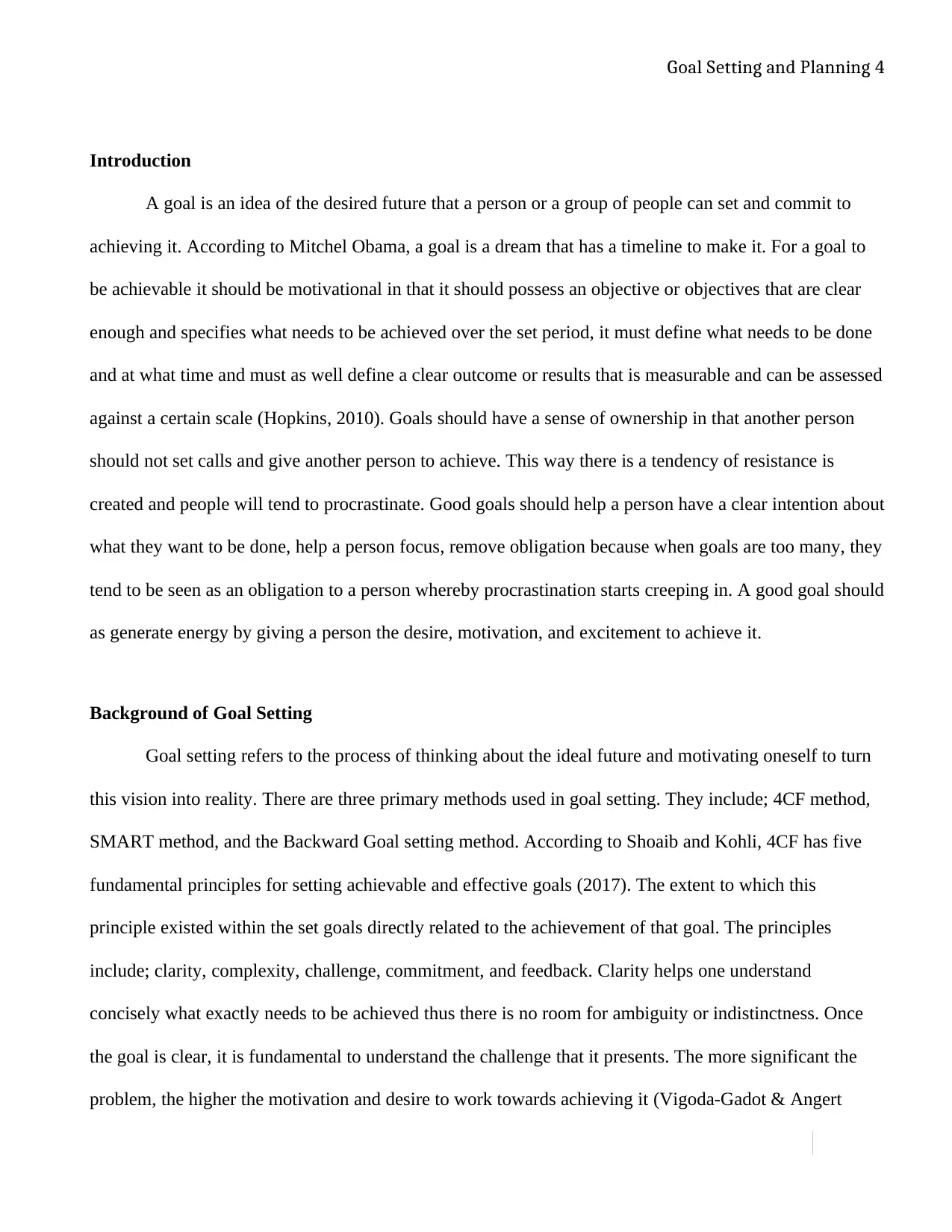
Goal Setting and Planning 4
Introduction
A goal is an idea of the desired future that a person or a group of people can set and commit to
achieving it. According to Mitchel Obama, a goal is a dream that has a timeline to make it. For a goal to
be achievable it should be motivational in that it should possess an objective or objectives that are clear
enough and specifies what needs to be achieved over the set period, it must define what needs to be done
and at what time and must as well define a clear outcome or results that is measurable and can be assessed
against a certain scale (Hopkins, 2010). Goals should have a sense of ownership in that another person
should not set calls and give another person to achieve. This way there is a tendency of resistance is
created and people will tend to procrastinate. Good goals should help a person have a clear intention about
what they want to be done, help a person focus, remove obligation because when goals are too many, they
tend to be seen as an obligation to a person whereby procrastination starts creeping in. A good goal should
as generate energy by giving a person the desire, motivation, and excitement to achieve it.
Background of Goal Setting
Goal setting refers to the process of thinking about the ideal future and motivating oneself to turn
this vision into reality. There are three primary methods used in goal setting. They include; 4CF method,
SMART method, and the Backward Goal setting method. According to Shoaib and Kohli, 4CF has five
fundamental principles for setting achievable and effective goals (2017). The extent to which this
principle existed within the set goals directly related to the achievement of that goal. The principles
include; clarity, complexity, challenge, commitment, and feedback. Clarity helps one understand
concisely what exactly needs to be achieved thus there is no room for ambiguity or indistinctness. Once
the goal is clear, it is fundamental to understand the challenge that it presents. The more significant the
problem, the higher the motivation and desire to work towards achieving it (Vigoda-Gadot & Angert
Introduction
A goal is an idea of the desired future that a person or a group of people can set and commit to
achieving it. According to Mitchel Obama, a goal is a dream that has a timeline to make it. For a goal to
be achievable it should be motivational in that it should possess an objective or objectives that are clear
enough and specifies what needs to be achieved over the set period, it must define what needs to be done
and at what time and must as well define a clear outcome or results that is measurable and can be assessed
against a certain scale (Hopkins, 2010). Goals should have a sense of ownership in that another person
should not set calls and give another person to achieve. This way there is a tendency of resistance is
created and people will tend to procrastinate. Good goals should help a person have a clear intention about
what they want to be done, help a person focus, remove obligation because when goals are too many, they
tend to be seen as an obligation to a person whereby procrastination starts creeping in. A good goal should
as generate energy by giving a person the desire, motivation, and excitement to achieve it.
Background of Goal Setting
Goal setting refers to the process of thinking about the ideal future and motivating oneself to turn
this vision into reality. There are three primary methods used in goal setting. They include; 4CF method,
SMART method, and the Backward Goal setting method. According to Shoaib and Kohli, 4CF has five
fundamental principles for setting achievable and effective goals (2017). The extent to which this
principle existed within the set goals directly related to the achievement of that goal. The principles
include; clarity, complexity, challenge, commitment, and feedback. Clarity helps one understand
concisely what exactly needs to be achieved thus there is no room for ambiguity or indistinctness. Once
the goal is clear, it is fundamental to understand the challenge that it presents. The more significant the
problem, the higher the motivation and desire to work towards achieving it (Vigoda-Gadot & Angert
Secure Best Marks with AI Grader
Need help grading? Try our AI Grader for instant feedback on your assignments.
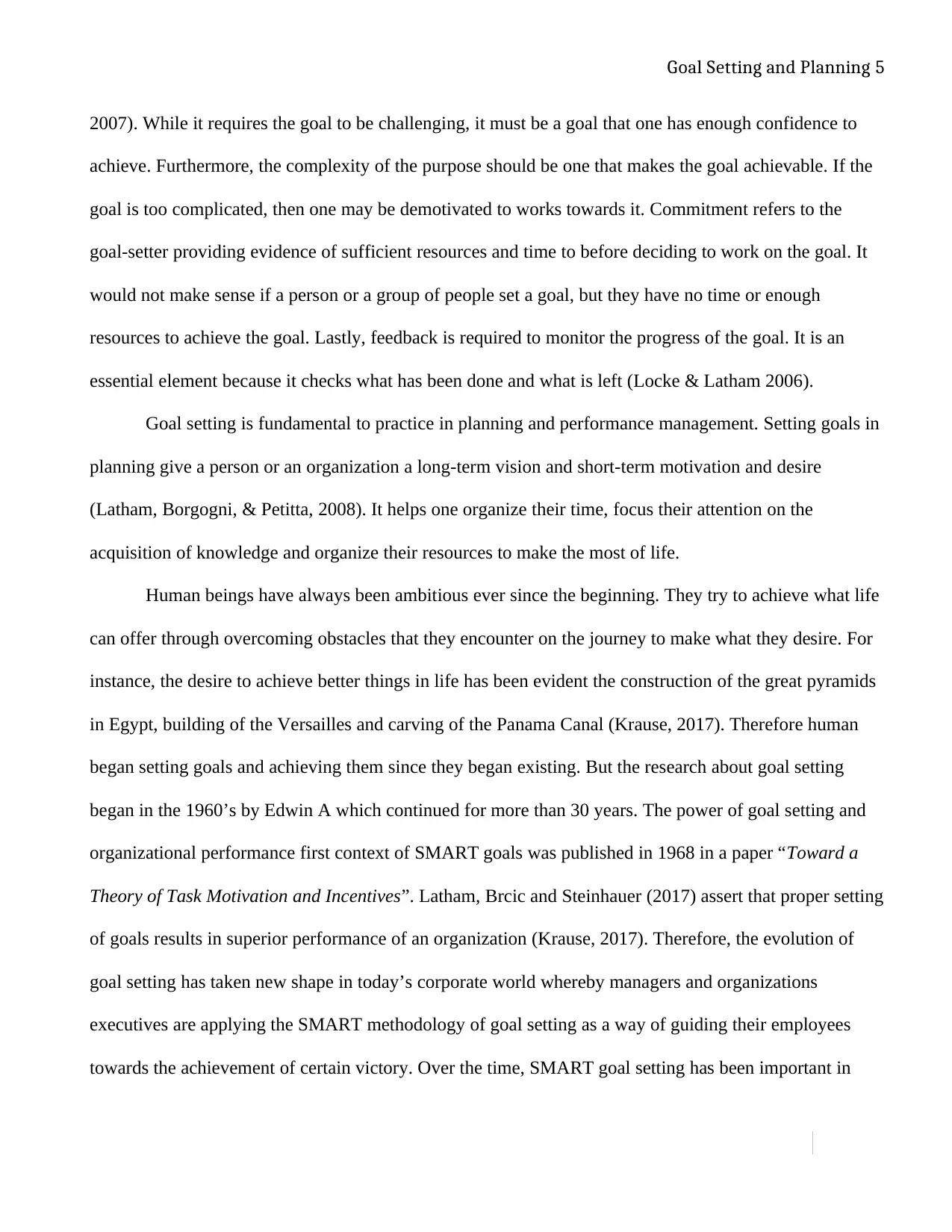
Goal Setting and Planning 5
2007). While it requires the goal to be challenging, it must be a goal that one has enough confidence to
achieve. Furthermore, the complexity of the purpose should be one that makes the goal achievable. If the
goal is too complicated, then one may be demotivated to works towards it. Commitment refers to the
goal-setter providing evidence of sufficient resources and time to before deciding to work on the goal. It
would not make sense if a person or a group of people set a goal, but they have no time or enough
resources to achieve the goal. Lastly, feedback is required to monitor the progress of the goal. It is an
essential element because it checks what has been done and what is left (Locke & Latham 2006).
Goal setting is fundamental to practice in planning and performance management. Setting goals in
planning give a person or an organization a long-term vision and short-term motivation and desire
(Latham, Borgogni, & Petitta, 2008). It helps one organize their time, focus their attention on the
acquisition of knowledge and organize their resources to make the most of life.
Human beings have always been ambitious ever since the beginning. They try to achieve what life
can offer through overcoming obstacles that they encounter on the journey to make what they desire. For
instance, the desire to achieve better things in life has been evident the construction of the great pyramids
in Egypt, building of the Versailles and carving of the Panama Canal (Krause, 2017). Therefore human
began setting goals and achieving them since they began existing. But the research about goal setting
began in the 1960’s by Edwin A which continued for more than 30 years. The power of goal setting and
organizational performance first context of SMART goals was published in 1968 in a paper “Toward a
Theory of Task Motivation and Incentives”. Latham, Brcic and Steinhauer (2017) assert that proper setting
of goals results in superior performance of an organization (Krause, 2017). Therefore, the evolution of
goal setting has taken new shape in today’s corporate world whereby managers and organizations
executives are applying the SMART methodology of goal setting as a way of guiding their employees
towards the achievement of certain victory. Over the time, SMART goal setting has been important in
2007). While it requires the goal to be challenging, it must be a goal that one has enough confidence to
achieve. Furthermore, the complexity of the purpose should be one that makes the goal achievable. If the
goal is too complicated, then one may be demotivated to works towards it. Commitment refers to the
goal-setter providing evidence of sufficient resources and time to before deciding to work on the goal. It
would not make sense if a person or a group of people set a goal, but they have no time or enough
resources to achieve the goal. Lastly, feedback is required to monitor the progress of the goal. It is an
essential element because it checks what has been done and what is left (Locke & Latham 2006).
Goal setting is fundamental to practice in planning and performance management. Setting goals in
planning give a person or an organization a long-term vision and short-term motivation and desire
(Latham, Borgogni, & Petitta, 2008). It helps one organize their time, focus their attention on the
acquisition of knowledge and organize their resources to make the most of life.
Human beings have always been ambitious ever since the beginning. They try to achieve what life
can offer through overcoming obstacles that they encounter on the journey to make what they desire. For
instance, the desire to achieve better things in life has been evident the construction of the great pyramids
in Egypt, building of the Versailles and carving of the Panama Canal (Krause, 2017). Therefore human
began setting goals and achieving them since they began existing. But the research about goal setting
began in the 1960’s by Edwin A which continued for more than 30 years. The power of goal setting and
organizational performance first context of SMART goals was published in 1968 in a paper “Toward a
Theory of Task Motivation and Incentives”. Latham, Brcic and Steinhauer (2017) assert that proper setting
of goals results in superior performance of an organization (Krause, 2017). Therefore, the evolution of
goal setting has taken new shape in today’s corporate world whereby managers and organizations
executives are applying the SMART methodology of goal setting as a way of guiding their employees
towards the achievement of certain victory. Over the time, SMART goal setting has been important in
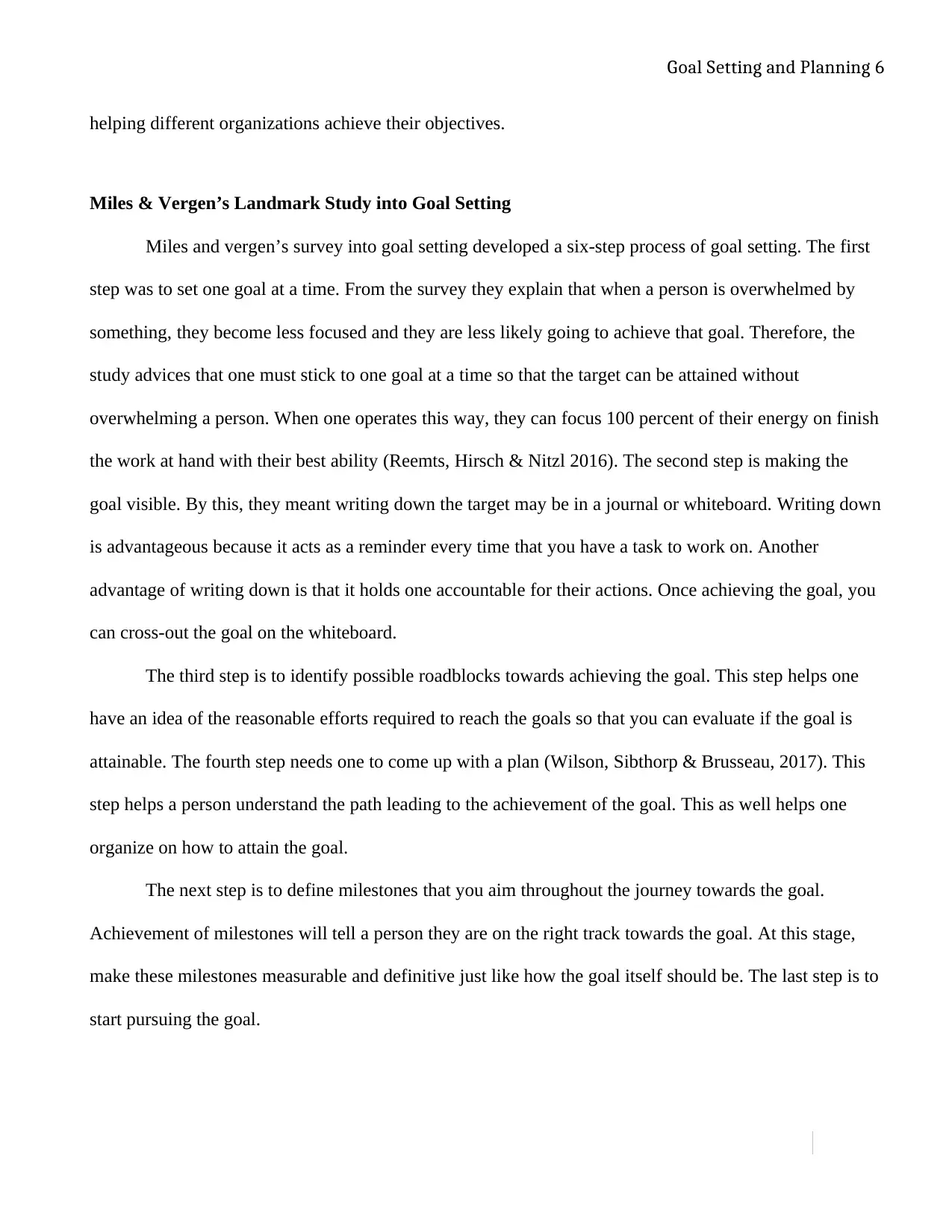
Goal Setting and Planning 6
helping different organizations achieve their objectives.
Miles & Vergen’s Landmark Study into Goal Setting
Miles and vergen’s survey into goal setting developed a six-step process of goal setting. The first
step was to set one goal at a time. From the survey they explain that when a person is overwhelmed by
something, they become less focused and they are less likely going to achieve that goal. Therefore, the
study advices that one must stick to one goal at a time so that the target can be attained without
overwhelming a person. When one operates this way, they can focus 100 percent of their energy on finish
the work at hand with their best ability (Reemts, Hirsch & Nitzl 2016). The second step is making the
goal visible. By this, they meant writing down the target may be in a journal or whiteboard. Writing down
is advantageous because it acts as a reminder every time that you have a task to work on. Another
advantage of writing down is that it holds one accountable for their actions. Once achieving the goal, you
can cross-out the goal on the whiteboard.
The third step is to identify possible roadblocks towards achieving the goal. This step helps one
have an idea of the reasonable efforts required to reach the goals so that you can evaluate if the goal is
attainable. The fourth step needs one to come up with a plan (Wilson, Sibthorp & Brusseau, 2017). This
step helps a person understand the path leading to the achievement of the goal. This as well helps one
organize on how to attain the goal.
The next step is to define milestones that you aim throughout the journey towards the goal.
Achievement of milestones will tell a person they are on the right track towards the goal. At this stage,
make these milestones measurable and definitive just like how the goal itself should be. The last step is to
start pursuing the goal.
helping different organizations achieve their objectives.
Miles & Vergen’s Landmark Study into Goal Setting
Miles and vergen’s survey into goal setting developed a six-step process of goal setting. The first
step was to set one goal at a time. From the survey they explain that when a person is overwhelmed by
something, they become less focused and they are less likely going to achieve that goal. Therefore, the
study advices that one must stick to one goal at a time so that the target can be attained without
overwhelming a person. When one operates this way, they can focus 100 percent of their energy on finish
the work at hand with their best ability (Reemts, Hirsch & Nitzl 2016). The second step is making the
goal visible. By this, they meant writing down the target may be in a journal or whiteboard. Writing down
is advantageous because it acts as a reminder every time that you have a task to work on. Another
advantage of writing down is that it holds one accountable for their actions. Once achieving the goal, you
can cross-out the goal on the whiteboard.
The third step is to identify possible roadblocks towards achieving the goal. This step helps one
have an idea of the reasonable efforts required to reach the goals so that you can evaluate if the goal is
attainable. The fourth step needs one to come up with a plan (Wilson, Sibthorp & Brusseau, 2017). This
step helps a person understand the path leading to the achievement of the goal. This as well helps one
organize on how to attain the goal.
The next step is to define milestones that you aim throughout the journey towards the goal.
Achievement of milestones will tell a person they are on the right track towards the goal. At this stage,
make these milestones measurable and definitive just like how the goal itself should be. The last step is to
start pursuing the goal.
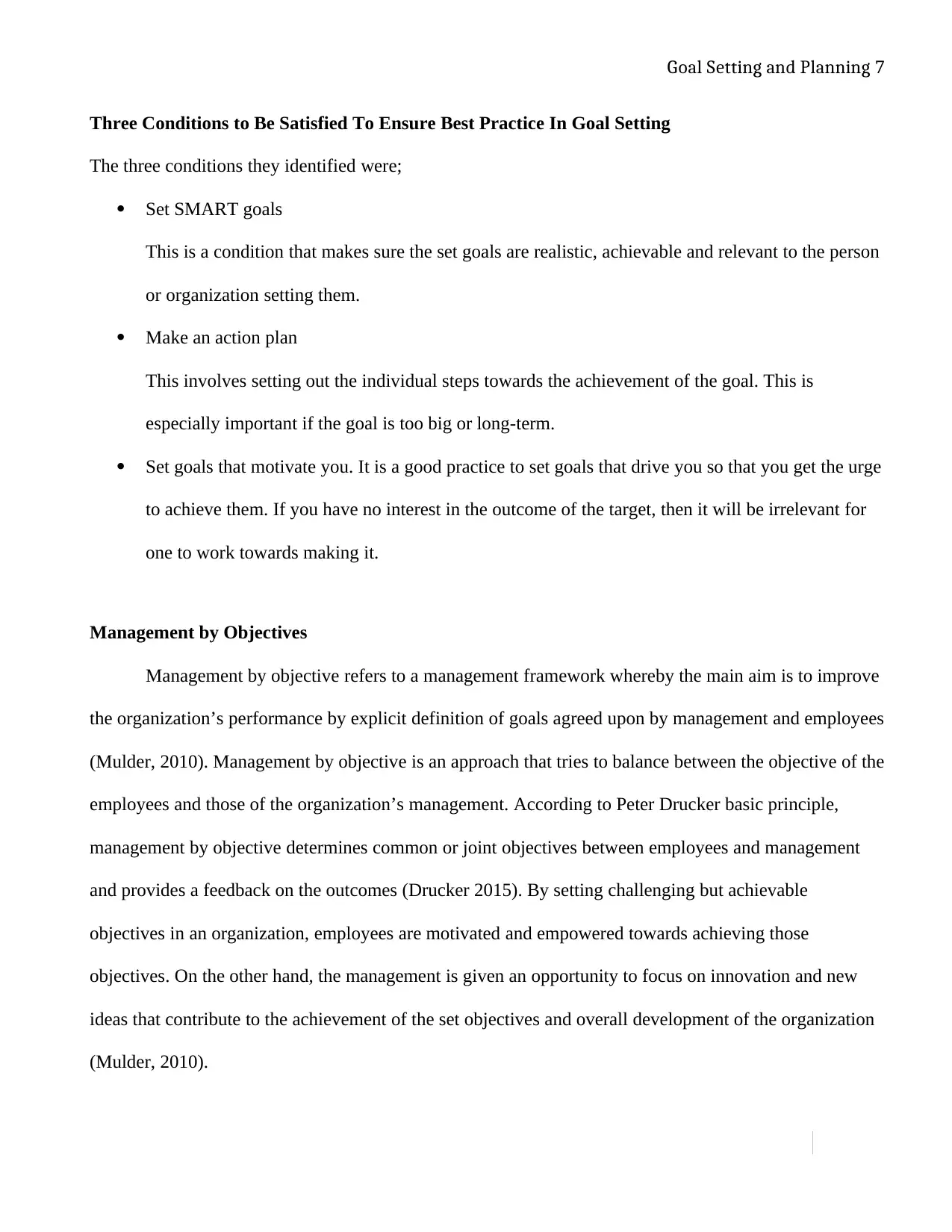
Goal Setting and Planning 7
Three Conditions to Be Satisfied To Ensure Best Practice In Goal Setting
The three conditions they identified were;
Set SMART goals
This is a condition that makes sure the set goals are realistic, achievable and relevant to the person
or organization setting them.
Make an action plan
This involves setting out the individual steps towards the achievement of the goal. This is
especially important if the goal is too big or long-term.
Set goals that motivate you. It is a good practice to set goals that drive you so that you get the urge
to achieve them. If you have no interest in the outcome of the target, then it will be irrelevant for
one to work towards making it.
Management by Objectives
Management by objective refers to a management framework whereby the main aim is to improve
the organization’s performance by explicit definition of goals agreed upon by management and employees
(Mulder, 2010). Management by objective is an approach that tries to balance between the objective of the
employees and those of the organization’s management. According to Peter Drucker basic principle,
management by objective determines common or joint objectives between employees and management
and provides a feedback on the outcomes (Drucker 2015). By setting challenging but achievable
objectives in an organization, employees are motivated and empowered towards achieving those
objectives. On the other hand, the management is given an opportunity to focus on innovation and new
ideas that contribute to the achievement of the set objectives and overall development of the organization
(Mulder, 2010).
Three Conditions to Be Satisfied To Ensure Best Practice In Goal Setting
The three conditions they identified were;
Set SMART goals
This is a condition that makes sure the set goals are realistic, achievable and relevant to the person
or organization setting them.
Make an action plan
This involves setting out the individual steps towards the achievement of the goal. This is
especially important if the goal is too big or long-term.
Set goals that motivate you. It is a good practice to set goals that drive you so that you get the urge
to achieve them. If you have no interest in the outcome of the target, then it will be irrelevant for
one to work towards making it.
Management by Objectives
Management by objective refers to a management framework whereby the main aim is to improve
the organization’s performance by explicit definition of goals agreed upon by management and employees
(Mulder, 2010). Management by objective is an approach that tries to balance between the objective of the
employees and those of the organization’s management. According to Peter Drucker basic principle,
management by objective determines common or joint objectives between employees and management
and provides a feedback on the outcomes (Drucker 2015). By setting challenging but achievable
objectives in an organization, employees are motivated and empowered towards achieving those
objectives. On the other hand, the management is given an opportunity to focus on innovation and new
ideas that contribute to the achievement of the set objectives and overall development of the organization
(Mulder, 2010).
Paraphrase This Document
Need a fresh take? Get an instant paraphrase of this document with our AI Paraphraser
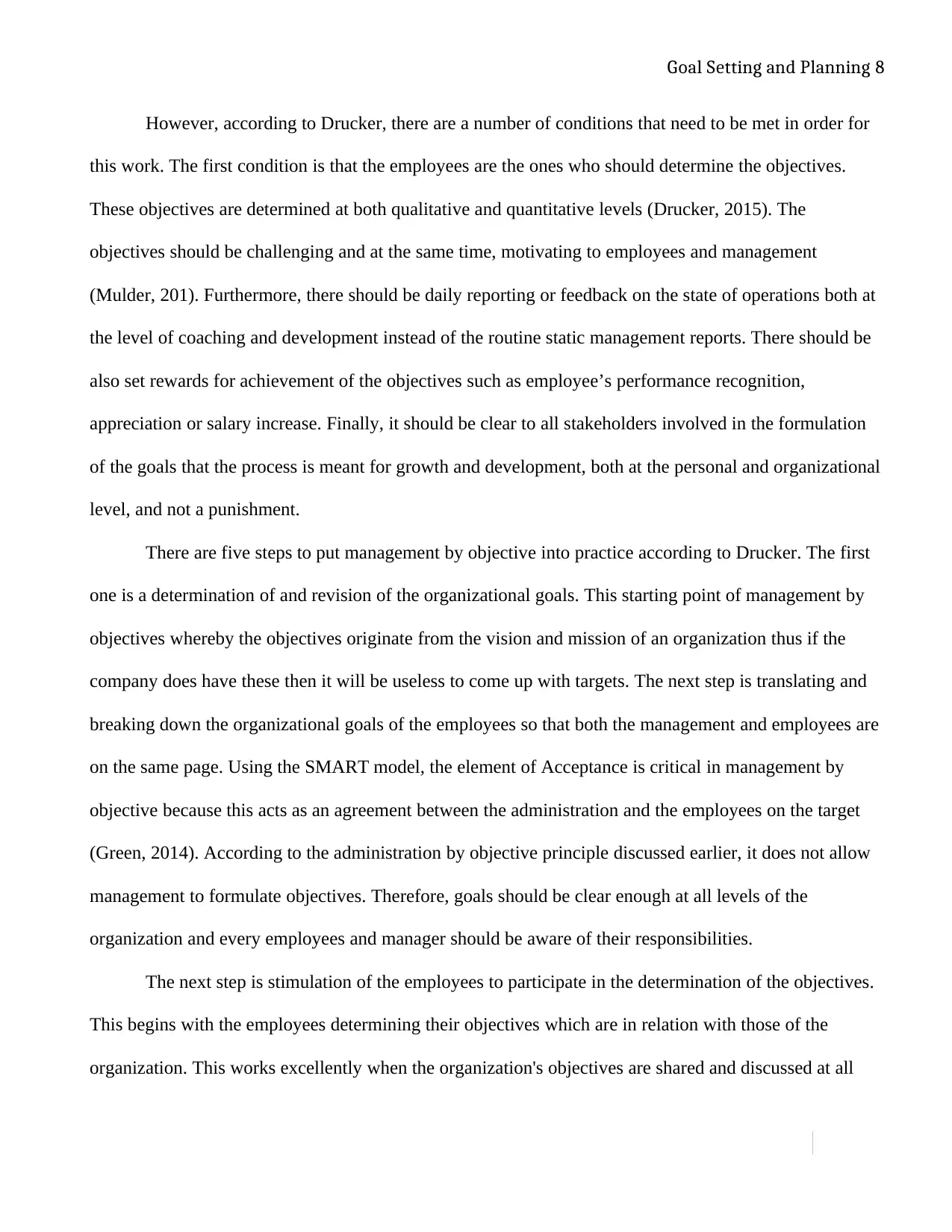
Goal Setting and Planning 8
However, according to Drucker, there are a number of conditions that need to be met in order for
this work. The first condition is that the employees are the ones who should determine the objectives.
These objectives are determined at both qualitative and quantitative levels (Drucker, 2015). The
objectives should be challenging and at the same time, motivating to employees and management
(Mulder, 201). Furthermore, there should be daily reporting or feedback on the state of operations both at
the level of coaching and development instead of the routine static management reports. There should be
also set rewards for achievement of the objectives such as employee’s performance recognition,
appreciation or salary increase. Finally, it should be clear to all stakeholders involved in the formulation
of the goals that the process is meant for growth and development, both at the personal and organizational
level, and not a punishment.
There are five steps to put management by objective into practice according to Drucker. The first
one is a determination of and revision of the organizational goals. This starting point of management by
objectives whereby the objectives originate from the vision and mission of an organization thus if the
company does have these then it will be useless to come up with targets. The next step is translating and
breaking down the organizational goals of the employees so that both the management and employees are
on the same page. Using the SMART model, the element of Acceptance is critical in management by
objective because this acts as an agreement between the administration and the employees on the target
(Green, 2014). According to the administration by objective principle discussed earlier, it does not allow
management to formulate objectives. Therefore, goals should be clear enough at all levels of the
organization and every employees and manager should be aware of their responsibilities.
The next step is stimulation of the employees to participate in the determination of the objectives.
This begins with the employees determining their objectives which are in relation with those of the
organization. This works excellently when the organization's objectives are shared and discussed at all
However, according to Drucker, there are a number of conditions that need to be met in order for
this work. The first condition is that the employees are the ones who should determine the objectives.
These objectives are determined at both qualitative and quantitative levels (Drucker, 2015). The
objectives should be challenging and at the same time, motivating to employees and management
(Mulder, 201). Furthermore, there should be daily reporting or feedback on the state of operations both at
the level of coaching and development instead of the routine static management reports. There should be
also set rewards for achievement of the objectives such as employee’s performance recognition,
appreciation or salary increase. Finally, it should be clear to all stakeholders involved in the formulation
of the goals that the process is meant for growth and development, both at the personal and organizational
level, and not a punishment.
There are five steps to put management by objective into practice according to Drucker. The first
one is a determination of and revision of the organizational goals. This starting point of management by
objectives whereby the objectives originate from the vision and mission of an organization thus if the
company does have these then it will be useless to come up with targets. The next step is translating and
breaking down the organizational goals of the employees so that both the management and employees are
on the same page. Using the SMART model, the element of Acceptance is critical in management by
objective because this acts as an agreement between the administration and the employees on the target
(Green, 2014). According to the administration by objective principle discussed earlier, it does not allow
management to formulate objectives. Therefore, goals should be clear enough at all levels of the
organization and every employees and manager should be aware of their responsibilities.
The next step is stimulation of the employees to participate in the determination of the objectives.
This begins with the employees determining their objectives which are in relation with those of the
organization. This works excellently when the organization's objectives are shared and discussed at all
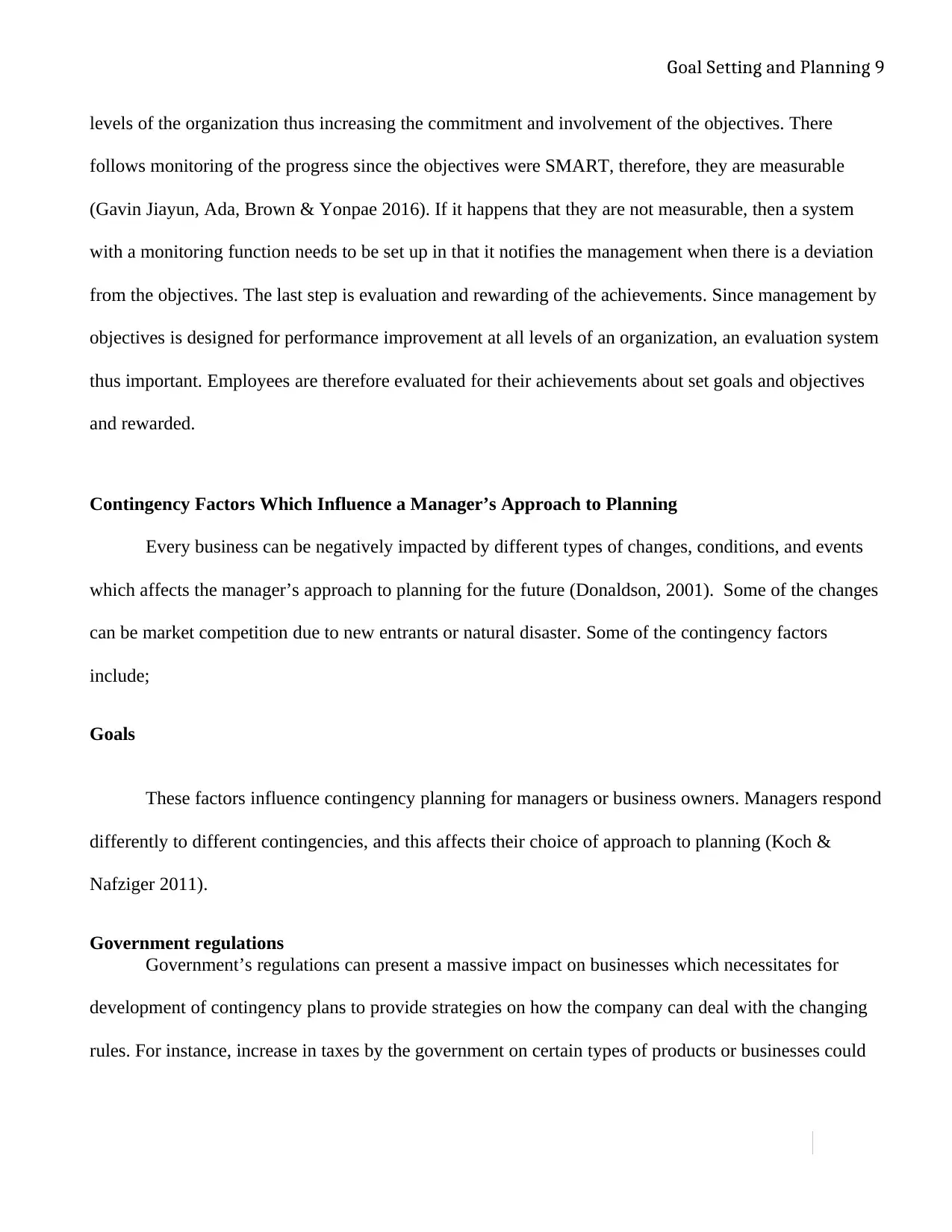
Goal Setting and Planning 9
levels of the organization thus increasing the commitment and involvement of the objectives. There
follows monitoring of the progress since the objectives were SMART, therefore, they are measurable
(Gavin Jiayun, Ada, Brown & Yonpae 2016). If it happens that they are not measurable, then a system
with a monitoring function needs to be set up in that it notifies the management when there is a deviation
from the objectives. The last step is evaluation and rewarding of the achievements. Since management by
objectives is designed for performance improvement at all levels of an organization, an evaluation system
thus important. Employees are therefore evaluated for their achievements about set goals and objectives
and rewarded.
Contingency Factors Which Influence a Manager’s Approach to Planning
Every business can be negatively impacted by different types of changes, conditions, and events
which affects the manager’s approach to planning for the future (Donaldson, 2001). Some of the changes
can be market competition due to new entrants or natural disaster. Some of the contingency factors
include;
Goals
These factors influence contingency planning for managers or business owners. Managers respond
differently to different contingencies, and this affects their choice of approach to planning (Koch &
Nafziger 2011).
Government regulations
Government’s regulations can present a massive impact on businesses which necessitates for
development of contingency plans to provide strategies on how the company can deal with the changing
rules. For instance, increase in taxes by the government on certain types of products or businesses could
levels of the organization thus increasing the commitment and involvement of the objectives. There
follows monitoring of the progress since the objectives were SMART, therefore, they are measurable
(Gavin Jiayun, Ada, Brown & Yonpae 2016). If it happens that they are not measurable, then a system
with a monitoring function needs to be set up in that it notifies the management when there is a deviation
from the objectives. The last step is evaluation and rewarding of the achievements. Since management by
objectives is designed for performance improvement at all levels of an organization, an evaluation system
thus important. Employees are therefore evaluated for their achievements about set goals and objectives
and rewarded.
Contingency Factors Which Influence a Manager’s Approach to Planning
Every business can be negatively impacted by different types of changes, conditions, and events
which affects the manager’s approach to planning for the future (Donaldson, 2001). Some of the changes
can be market competition due to new entrants or natural disaster. Some of the contingency factors
include;
Goals
These factors influence contingency planning for managers or business owners. Managers respond
differently to different contingencies, and this affects their choice of approach to planning (Koch &
Nafziger 2011).
Government regulations
Government’s regulations can present a massive impact on businesses which necessitates for
development of contingency plans to provide strategies on how the company can deal with the changing
rules. For instance, increase in taxes by the government on certain types of products or businesses could
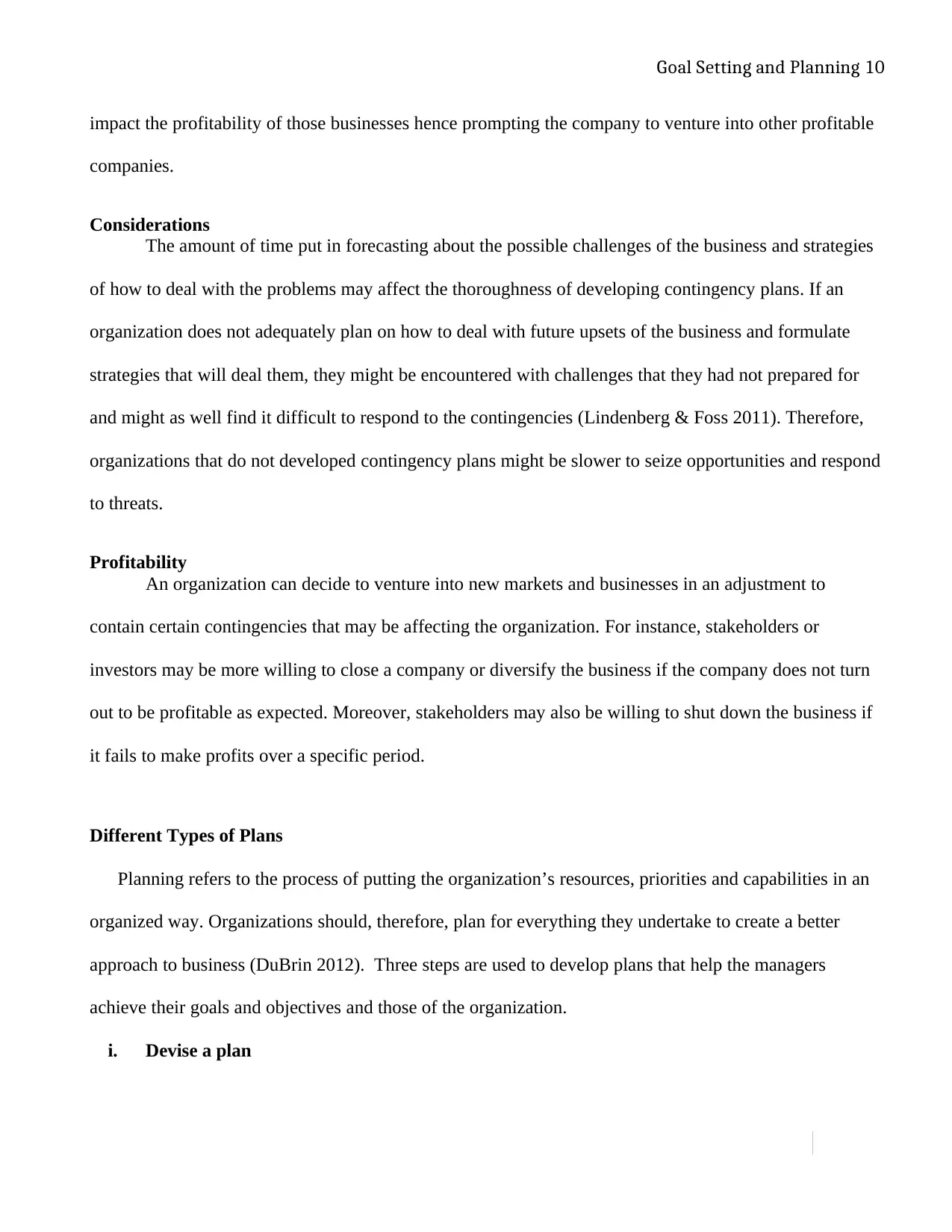
Goal Setting and Planning 10
impact the profitability of those businesses hence prompting the company to venture into other profitable
companies.
Considerations
The amount of time put in forecasting about the possible challenges of the business and strategies
of how to deal with the problems may affect the thoroughness of developing contingency plans. If an
organization does not adequately plan on how to deal with future upsets of the business and formulate
strategies that will deal them, they might be encountered with challenges that they had not prepared for
and might as well find it difficult to respond to the contingencies (Lindenberg & Foss 2011). Therefore,
organizations that do not developed contingency plans might be slower to seize opportunities and respond
to threats.
Profitability
An organization can decide to venture into new markets and businesses in an adjustment to
contain certain contingencies that may be affecting the organization. For instance, stakeholders or
investors may be more willing to close a company or diversify the business if the company does not turn
out to be profitable as expected. Moreover, stakeholders may also be willing to shut down the business if
it fails to make profits over a specific period.
Different Types of Plans
Planning refers to the process of putting the organization’s resources, priorities and capabilities in an
organized way. Organizations should, therefore, plan for everything they undertake to create a better
approach to business (DuBrin 2012). Three steps are used to develop plans that help the managers
achieve their goals and objectives and those of the organization.
i. Devise a plan
impact the profitability of those businesses hence prompting the company to venture into other profitable
companies.
Considerations
The amount of time put in forecasting about the possible challenges of the business and strategies
of how to deal with the problems may affect the thoroughness of developing contingency plans. If an
organization does not adequately plan on how to deal with future upsets of the business and formulate
strategies that will deal them, they might be encountered with challenges that they had not prepared for
and might as well find it difficult to respond to the contingencies (Lindenberg & Foss 2011). Therefore,
organizations that do not developed contingency plans might be slower to seize opportunities and respond
to threats.
Profitability
An organization can decide to venture into new markets and businesses in an adjustment to
contain certain contingencies that may be affecting the organization. For instance, stakeholders or
investors may be more willing to close a company or diversify the business if the company does not turn
out to be profitable as expected. Moreover, stakeholders may also be willing to shut down the business if
it fails to make profits over a specific period.
Different Types of Plans
Planning refers to the process of putting the organization’s resources, priorities and capabilities in an
organized way. Organizations should, therefore, plan for everything they undertake to create a better
approach to business (DuBrin 2012). Three steps are used to develop plans that help the managers
achieve their goals and objectives and those of the organization.
i. Devise a plan
Secure Best Marks with AI Grader
Need help grading? Try our AI Grader for instant feedback on your assignments.
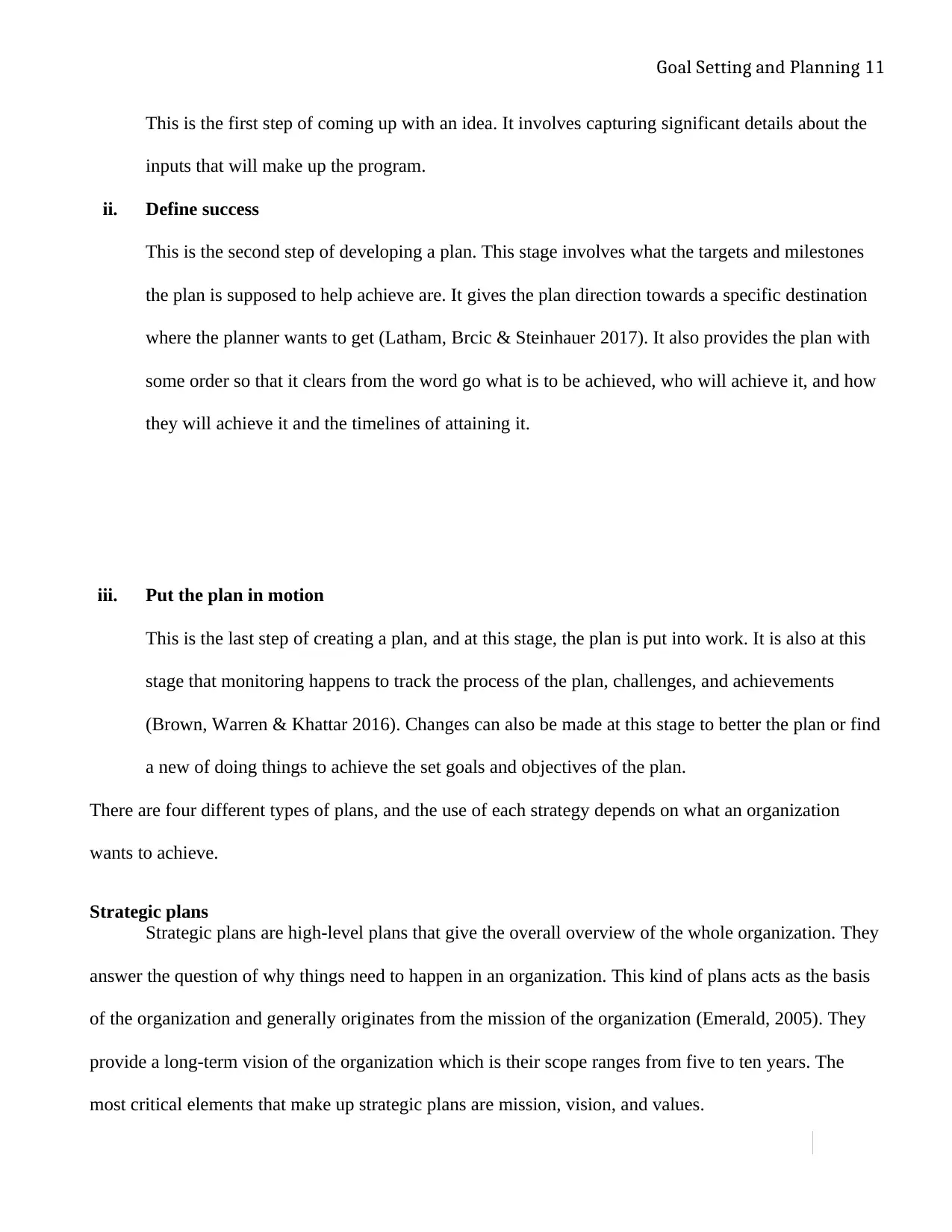
Goal Setting and Planning 11
This is the first step of coming up with an idea. It involves capturing significant details about the
inputs that will make up the program.
ii. Define success
This is the second step of developing a plan. This stage involves what the targets and milestones
the plan is supposed to help achieve are. It gives the plan direction towards a specific destination
where the planner wants to get (Latham, Brcic & Steinhauer 2017). It also provides the plan with
some order so that it clears from the word go what is to be achieved, who will achieve it, and how
they will achieve it and the timelines of attaining it.
iii. Put the plan in motion
This is the last step of creating a plan, and at this stage, the plan is put into work. It is also at this
stage that monitoring happens to track the process of the plan, challenges, and achievements
(Brown, Warren & Khattar 2016). Changes can also be made at this stage to better the plan or find
a new of doing things to achieve the set goals and objectives of the plan.
There are four different types of plans, and the use of each strategy depends on what an organization
wants to achieve.
Strategic plans
Strategic plans are high-level plans that give the overall overview of the whole organization. They
answer the question of why things need to happen in an organization. This kind of plans acts as the basis
of the organization and generally originates from the mission of the organization (Emerald, 2005). They
provide a long-term vision of the organization which is their scope ranges from five to ten years. The
most critical elements that make up strategic plans are mission, vision, and values.
This is the first step of coming up with an idea. It involves capturing significant details about the
inputs that will make up the program.
ii. Define success
This is the second step of developing a plan. This stage involves what the targets and milestones
the plan is supposed to help achieve are. It gives the plan direction towards a specific destination
where the planner wants to get (Latham, Brcic & Steinhauer 2017). It also provides the plan with
some order so that it clears from the word go what is to be achieved, who will achieve it, and how
they will achieve it and the timelines of attaining it.
iii. Put the plan in motion
This is the last step of creating a plan, and at this stage, the plan is put into work. It is also at this
stage that monitoring happens to track the process of the plan, challenges, and achievements
(Brown, Warren & Khattar 2016). Changes can also be made at this stage to better the plan or find
a new of doing things to achieve the set goals and objectives of the plan.
There are four different types of plans, and the use of each strategy depends on what an organization
wants to achieve.
Strategic plans
Strategic plans are high-level plans that give the overall overview of the whole organization. They
answer the question of why things need to happen in an organization. This kind of plans acts as the basis
of the organization and generally originates from the mission of the organization (Emerald, 2005). They
provide a long-term vision of the organization which is their scope ranges from five to ten years. The
most critical elements that make up strategic plans are mission, vision, and values.
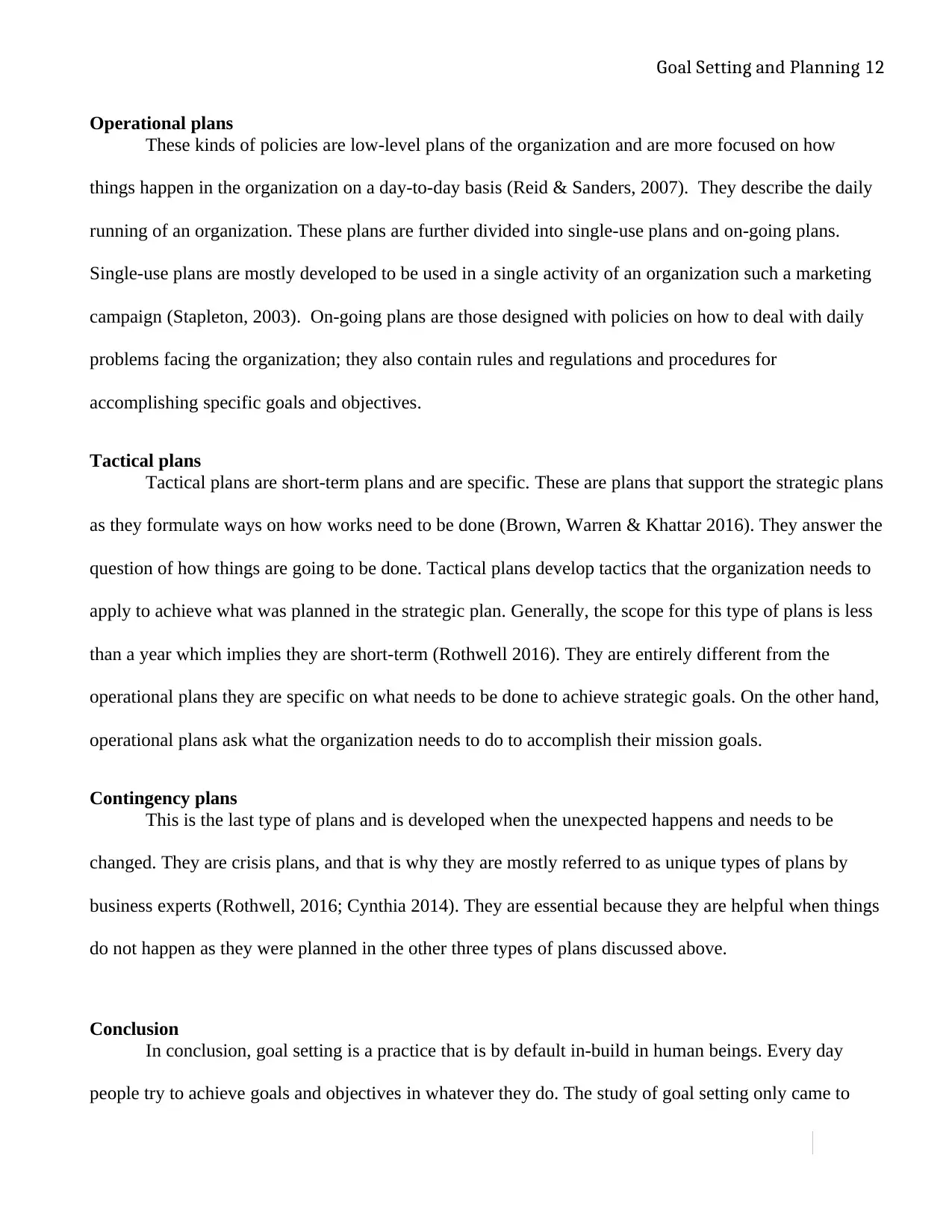
Goal Setting and Planning 12
Operational plans
These kinds of policies are low-level plans of the organization and are more focused on how
things happen in the organization on a day-to-day basis (Reid & Sanders, 2007). They describe the daily
running of an organization. These plans are further divided into single-use plans and on-going plans.
Single-use plans are mostly developed to be used in a single activity of an organization such a marketing
campaign (Stapleton, 2003). On-going plans are those designed with policies on how to deal with daily
problems facing the organization; they also contain rules and regulations and procedures for
accomplishing specific goals and objectives.
Tactical plans
Tactical plans are short-term plans and are specific. These are plans that support the strategic plans
as they formulate ways on how works need to be done (Brown, Warren & Khattar 2016). They answer the
question of how things are going to be done. Tactical plans develop tactics that the organization needs to
apply to achieve what was planned in the strategic plan. Generally, the scope for this type of plans is less
than a year which implies they are short-term (Rothwell 2016). They are entirely different from the
operational plans they are specific on what needs to be done to achieve strategic goals. On the other hand,
operational plans ask what the organization needs to do to accomplish their mission goals.
Contingency plans
This is the last type of plans and is developed when the unexpected happens and needs to be
changed. They are crisis plans, and that is why they are mostly referred to as unique types of plans by
business experts (Rothwell, 2016; Cynthia 2014). They are essential because they are helpful when things
do not happen as they were planned in the other three types of plans discussed above.
Conclusion
In conclusion, goal setting is a practice that is by default in-build in human beings. Every day
people try to achieve goals and objectives in whatever they do. The study of goal setting only came to
Operational plans
These kinds of policies are low-level plans of the organization and are more focused on how
things happen in the organization on a day-to-day basis (Reid & Sanders, 2007). They describe the daily
running of an organization. These plans are further divided into single-use plans and on-going plans.
Single-use plans are mostly developed to be used in a single activity of an organization such a marketing
campaign (Stapleton, 2003). On-going plans are those designed with policies on how to deal with daily
problems facing the organization; they also contain rules and regulations and procedures for
accomplishing specific goals and objectives.
Tactical plans
Tactical plans are short-term plans and are specific. These are plans that support the strategic plans
as they formulate ways on how works need to be done (Brown, Warren & Khattar 2016). They answer the
question of how things are going to be done. Tactical plans develop tactics that the organization needs to
apply to achieve what was planned in the strategic plan. Generally, the scope for this type of plans is less
than a year which implies they are short-term (Rothwell 2016). They are entirely different from the
operational plans they are specific on what needs to be done to achieve strategic goals. On the other hand,
operational plans ask what the organization needs to do to accomplish their mission goals.
Contingency plans
This is the last type of plans and is developed when the unexpected happens and needs to be
changed. They are crisis plans, and that is why they are mostly referred to as unique types of plans by
business experts (Rothwell, 2016; Cynthia 2014). They are essential because they are helpful when things
do not happen as they were planned in the other three types of plans discussed above.
Conclusion
In conclusion, goal setting is a practice that is by default in-build in human beings. Every day
people try to achieve goals and objectives in whatever they do. The study of goal setting only came to
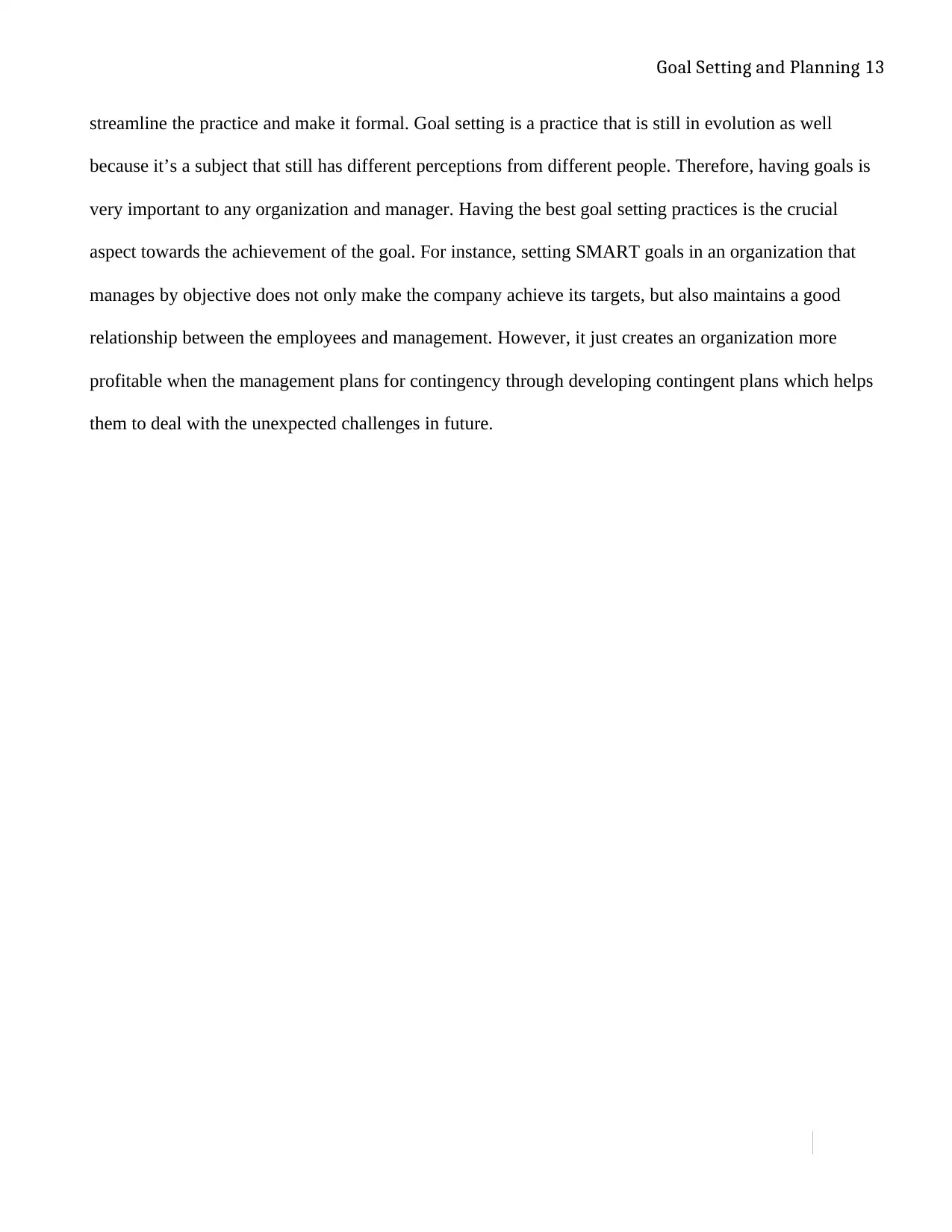
Goal Setting and Planning 13
streamline the practice and make it formal. Goal setting is a practice that is still in evolution as well
because it’s a subject that still has different perceptions from different people. Therefore, having goals is
very important to any organization and manager. Having the best goal setting practices is the crucial
aspect towards the achievement of the goal. For instance, setting SMART goals in an organization that
manages by objective does not only make the company achieve its targets, but also maintains a good
relationship between the employees and management. However, it just creates an organization more
profitable when the management plans for contingency through developing contingent plans which helps
them to deal with the unexpected challenges in future.
streamline the practice and make it formal. Goal setting is a practice that is still in evolution as well
because it’s a subject that still has different perceptions from different people. Therefore, having goals is
very important to any organization and manager. Having the best goal setting practices is the crucial
aspect towards the achievement of the goal. For instance, setting SMART goals in an organization that
manages by objective does not only make the company achieve its targets, but also maintains a good
relationship between the employees and management. However, it just creates an organization more
profitable when the management plans for contingency through developing contingent plans which helps
them to deal with the unexpected challenges in future.
Paraphrase This Document
Need a fresh take? Get an instant paraphrase of this document with our AI Paraphraser
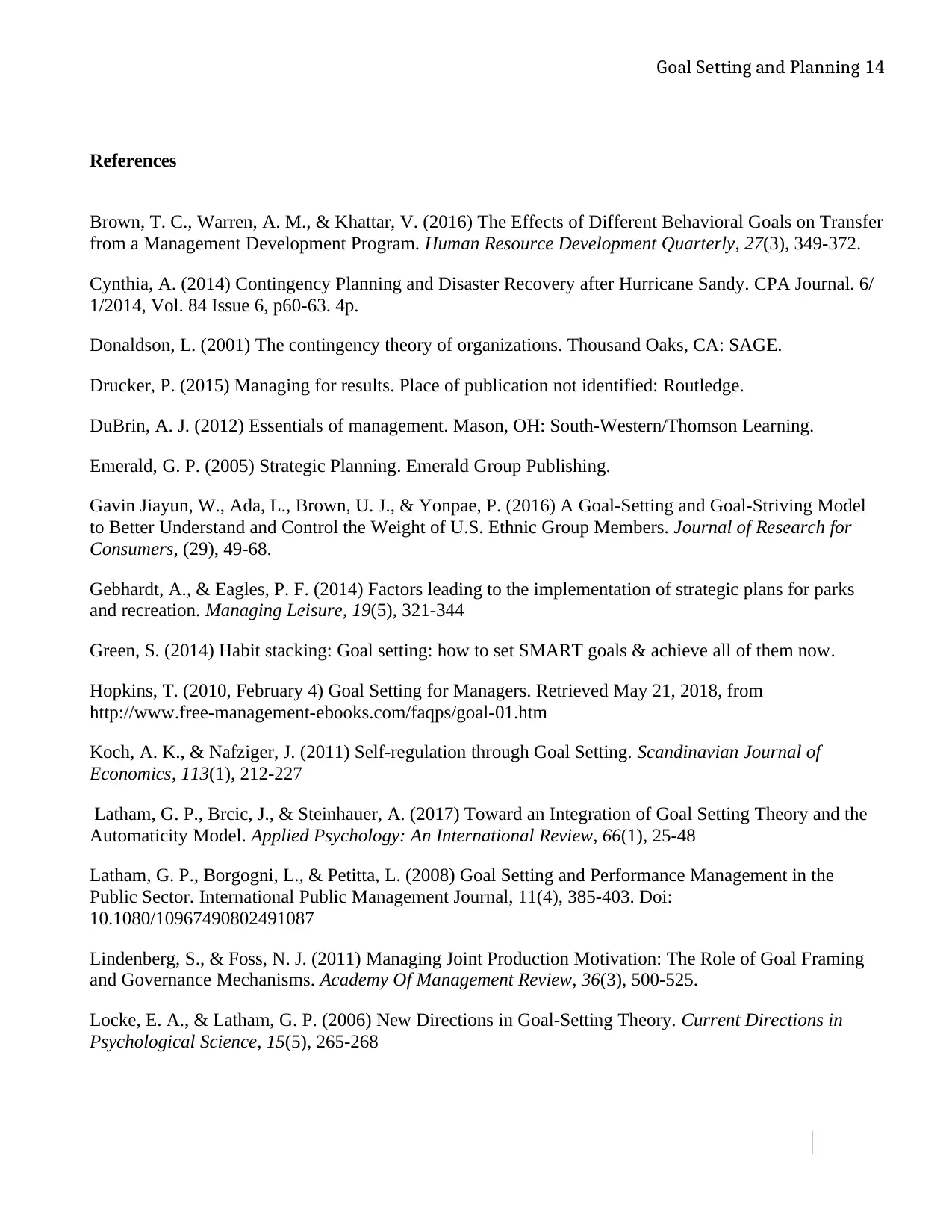
Goal Setting and Planning 14
References
Brown, T. C., Warren, A. M., & Khattar, V. (2016) The Effects of Different Behavioral Goals on Transfer
from a Management Development Program. Human Resource Development Quarterly, 27(3), 349-372.
Cynthia, A. (2014) Contingency Planning and Disaster Recovery after Hurricane Sandy. CPA Journal. 6/
1/2014, Vol. 84 Issue 6, p60-63. 4p.
Donaldson, L. (2001) The contingency theory of organizations. Thousand Oaks, CA: SAGE.
Drucker, P. (2015) Managing for results. Place of publication not identified: Routledge.
DuBrin, A. J. (2012) Essentials of management. Mason, OH: South-Western/Thomson Learning.
Emerald, G. P. (2005) Strategic Planning. Emerald Group Publishing.
Gavin Jiayun, W., Ada, L., Brown, U. J., & Yonpae, P. (2016) A Goal-Setting and Goal-Striving Model
to Better Understand and Control the Weight of U.S. Ethnic Group Members. Journal of Research for
Consumers, (29), 49-68.
Gebhardt, A., & Eagles, P. F. (2014) Factors leading to the implementation of strategic plans for parks
and recreation. Managing Leisure, 19(5), 321-344
Green, S. (2014) Habit stacking: Goal setting: how to set SMART goals & achieve all of them now.
Hopkins, T. (2010, February 4) Goal Setting for Managers. Retrieved May 21, 2018, from
http://www.free-management-ebooks.com/faqps/goal-01.htm
Koch, A. K., & Nafziger, J. (2011) Self-regulation through Goal Setting. Scandinavian Journal of
Economics, 113(1), 212-227
Latham, G. P., Brcic, J., & Steinhauer, A. (2017) Toward an Integration of Goal Setting Theory and the
Automaticity Model. Applied Psychology: An International Review, 66(1), 25-48
Latham, G. P., Borgogni, L., & Petitta, L. (2008) Goal Setting and Performance Management in the
Public Sector. International Public Management Journal, 11(4), 385-403. Doi:
10.1080/10967490802491087
Lindenberg, S., & Foss, N. J. (2011) Managing Joint Production Motivation: The Role of Goal Framing
and Governance Mechanisms. Academy Of Management Review, 36(3), 500-525.
Locke, E. A., & Latham, G. P. (2006) New Directions in Goal-Setting Theory. Current Directions in
Psychological Science, 15(5), 265-268
References
Brown, T. C., Warren, A. M., & Khattar, V. (2016) The Effects of Different Behavioral Goals on Transfer
from a Management Development Program. Human Resource Development Quarterly, 27(3), 349-372.
Cynthia, A. (2014) Contingency Planning and Disaster Recovery after Hurricane Sandy. CPA Journal. 6/
1/2014, Vol. 84 Issue 6, p60-63. 4p.
Donaldson, L. (2001) The contingency theory of organizations. Thousand Oaks, CA: SAGE.
Drucker, P. (2015) Managing for results. Place of publication not identified: Routledge.
DuBrin, A. J. (2012) Essentials of management. Mason, OH: South-Western/Thomson Learning.
Emerald, G. P. (2005) Strategic Planning. Emerald Group Publishing.
Gavin Jiayun, W., Ada, L., Brown, U. J., & Yonpae, P. (2016) A Goal-Setting and Goal-Striving Model
to Better Understand and Control the Weight of U.S. Ethnic Group Members. Journal of Research for
Consumers, (29), 49-68.
Gebhardt, A., & Eagles, P. F. (2014) Factors leading to the implementation of strategic plans for parks
and recreation. Managing Leisure, 19(5), 321-344
Green, S. (2014) Habit stacking: Goal setting: how to set SMART goals & achieve all of them now.
Hopkins, T. (2010, February 4) Goal Setting for Managers. Retrieved May 21, 2018, from
http://www.free-management-ebooks.com/faqps/goal-01.htm
Koch, A. K., & Nafziger, J. (2011) Self-regulation through Goal Setting. Scandinavian Journal of
Economics, 113(1), 212-227
Latham, G. P., Brcic, J., & Steinhauer, A. (2017) Toward an Integration of Goal Setting Theory and the
Automaticity Model. Applied Psychology: An International Review, 66(1), 25-48
Latham, G. P., Borgogni, L., & Petitta, L. (2008) Goal Setting and Performance Management in the
Public Sector. International Public Management Journal, 11(4), 385-403. Doi:
10.1080/10967490802491087
Lindenberg, S., & Foss, N. J. (2011) Managing Joint Production Motivation: The Role of Goal Framing
and Governance Mechanisms. Academy Of Management Review, 36(3), 500-525.
Locke, E. A., & Latham, G. P. (2006) New Directions in Goal-Setting Theory. Current Directions in
Psychological Science, 15(5), 265-268
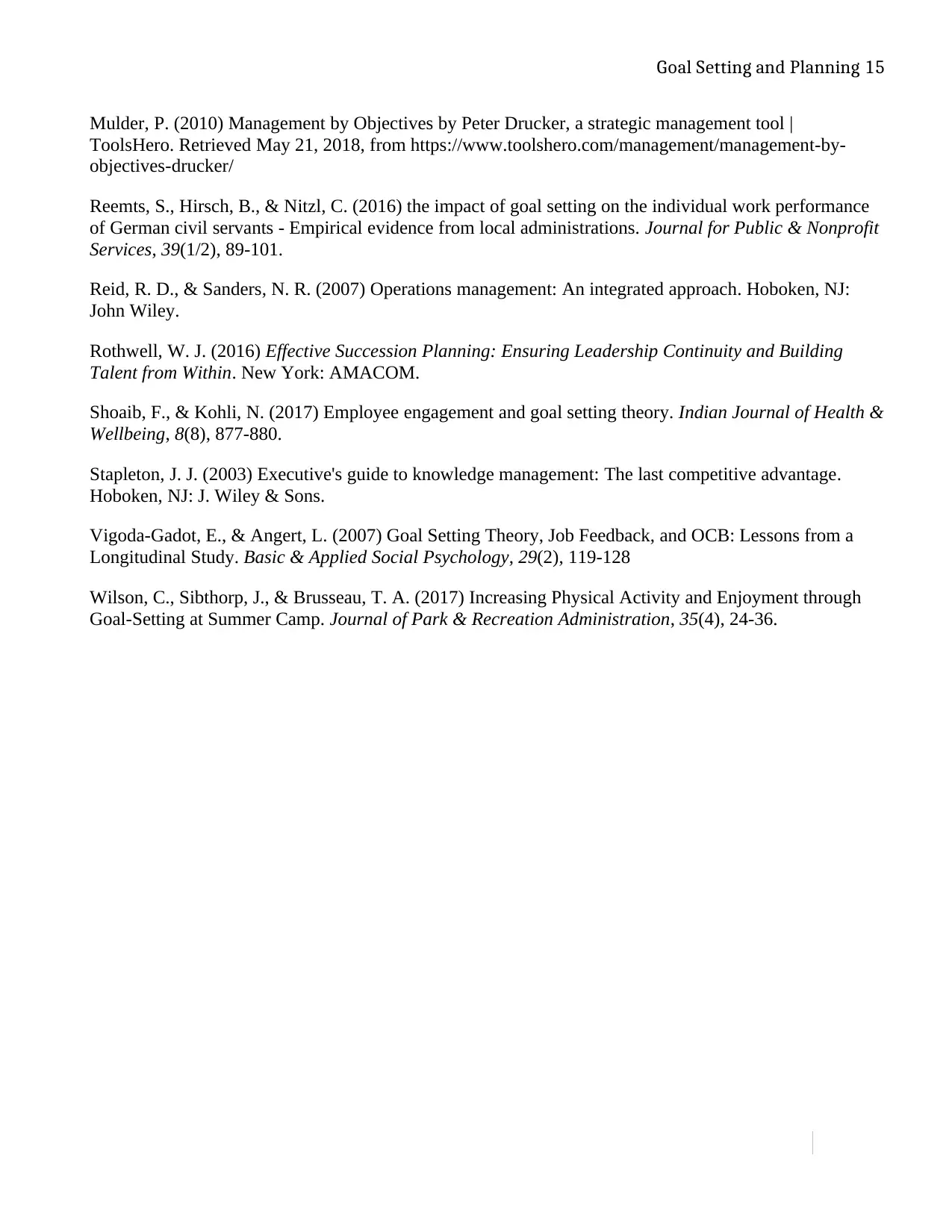
Goal Setting and Planning 15
Mulder, P. (2010) Management by Objectives by Peter Drucker, a strategic management tool |
ToolsHero. Retrieved May 21, 2018, from https://www.toolshero.com/management/management-by-
objectives-drucker/
Reemts, S., Hirsch, B., & Nitzl, C. (2016) the impact of goal setting on the individual work performance
of German civil servants - Empirical evidence from local administrations. Journal for Public & Nonprofit
Services, 39(1/2), 89-101.
Reid, R. D., & Sanders, N. R. (2007) Operations management: An integrated approach. Hoboken, NJ:
John Wiley.
Rothwell, W. J. (2016) Effective Succession Planning: Ensuring Leadership Continuity and Building
Talent from Within. New York: AMACOM.
Shoaib, F., & Kohli, N. (2017) Employee engagement and goal setting theory. Indian Journal of Health &
Wellbeing, 8(8), 877-880.
Stapleton, J. J. (2003) Executive's guide to knowledge management: The last competitive advantage.
Hoboken, NJ: J. Wiley & Sons.
Vigoda-Gadot, E., & Angert, L. (2007) Goal Setting Theory, Job Feedback, and OCB: Lessons from a
Longitudinal Study. Basic & Applied Social Psychology, 29(2), 119-128
Wilson, C., Sibthorp, J., & Brusseau, T. A. (2017) Increasing Physical Activity and Enjoyment through
Goal-Setting at Summer Camp. Journal of Park & Recreation Administration, 35(4), 24-36.
Mulder, P. (2010) Management by Objectives by Peter Drucker, a strategic management tool |
ToolsHero. Retrieved May 21, 2018, from https://www.toolshero.com/management/management-by-
objectives-drucker/
Reemts, S., Hirsch, B., & Nitzl, C. (2016) the impact of goal setting on the individual work performance
of German civil servants - Empirical evidence from local administrations. Journal for Public & Nonprofit
Services, 39(1/2), 89-101.
Reid, R. D., & Sanders, N. R. (2007) Operations management: An integrated approach. Hoboken, NJ:
John Wiley.
Rothwell, W. J. (2016) Effective Succession Planning: Ensuring Leadership Continuity and Building
Talent from Within. New York: AMACOM.
Shoaib, F., & Kohli, N. (2017) Employee engagement and goal setting theory. Indian Journal of Health &
Wellbeing, 8(8), 877-880.
Stapleton, J. J. (2003) Executive's guide to knowledge management: The last competitive advantage.
Hoboken, NJ: J. Wiley & Sons.
Vigoda-Gadot, E., & Angert, L. (2007) Goal Setting Theory, Job Feedback, and OCB: Lessons from a
Longitudinal Study. Basic & Applied Social Psychology, 29(2), 119-128
Wilson, C., Sibthorp, J., & Brusseau, T. A. (2017) Increasing Physical Activity and Enjoyment through
Goal-Setting at Summer Camp. Journal of Park & Recreation Administration, 35(4), 24-36.
1 out of 15
Related Documents
Your All-in-One AI-Powered Toolkit for Academic Success.
+13062052269
info@desklib.com
Available 24*7 on WhatsApp / Email
![[object Object]](/_next/static/media/star-bottom.7253800d.svg)
Unlock your academic potential
© 2024 | Zucol Services PVT LTD | All rights reserved.





